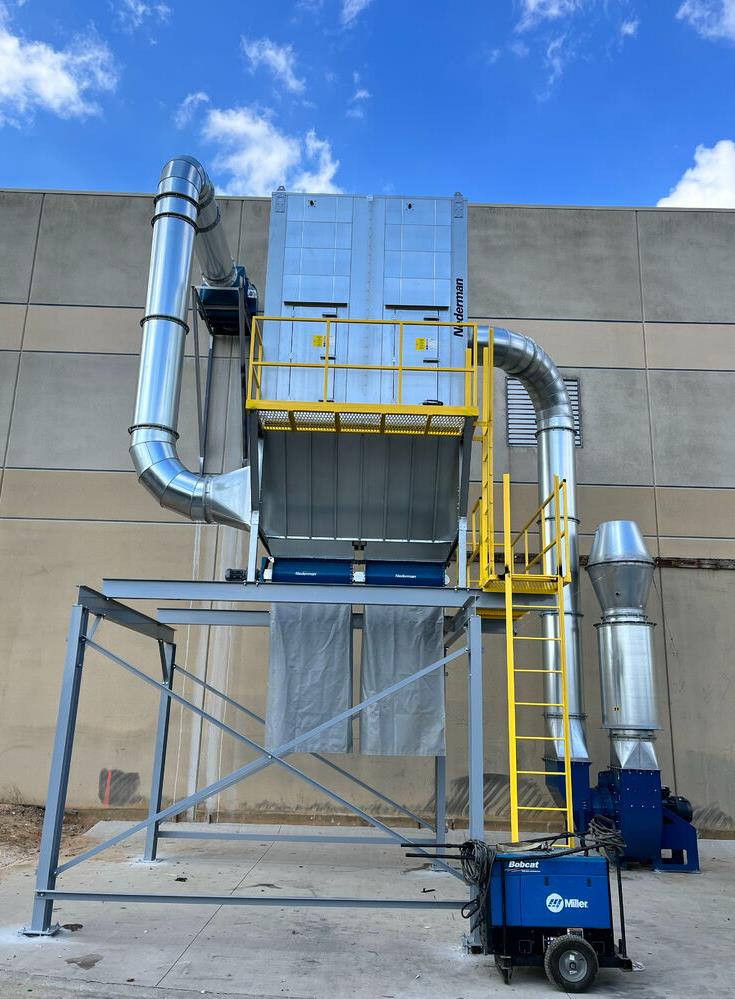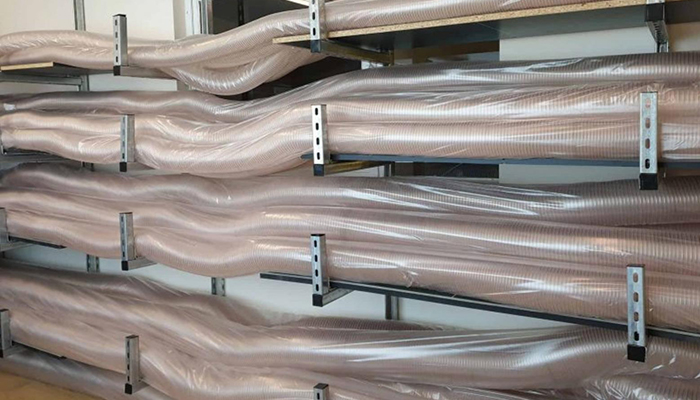What Is The Best Type Of Ductwork For A Dust Collection System?
When it comes to dust collection systems, your choice of ductwork will determine how well your system works for you and how long it lasts. Choosing the right type of ductwork is important because once your system is up and running, trying to add different types of ductwork can be very difficult and messy. Read this post to find out what type of ductwork works best for dust collection systems and why!
What’s Ductwork
Ductwork is any way that air can be moved. Or you can define it as an enclosed pipe or tube through which air travels from one place to another. In addition, it includes all the necessary parts, such as elbows and fittings.
Its industrial applications include transferring air from one location to another in heating, ventilation, and cooling systems; conveying foul or contaminated air away from workers in areas where airborne hazards exist; supplying combustion air for stoves, furnaces, boilers, water heaters, and fireplaces; exhausting fumes or smoke out of buildings via chimneys or flues; delivering large volumes of fresh outside air into buildings.
What’s A Dust Collection System

A dust collection system is any apparatus that collects the dust, debris, and chips generated by various systems. A dust collection system aims to improve air quality by keeping all material (including toxic material like wood particles) out of the air.
Dust collection systems eliminate or minimize fire hazards caused by the accumulation of sawdust or other combustible materials. Also, as seen in many industries, such as cabinet making, steel fabrication, and joinery, certain types of dust are health hazards.
Finally, you’ll find dust collection systems in various industries, such as wood and paper, grain and granule transport, exhaust fumes,construction, oil & gas Industry, foodstuff manufacturing,plastics manufacturing,pneumatic conveying,pharmaceutical production,pharmaceutical production and steel fabrication. v
Benefits Of Ductwork In Dust Collection System

So how does an air duct system help in dust collection systems? Ducts can be used to protect the user and make their jobs easier. You need to use them in your dust collection systems because they have so many benefits that you don’t wish to miss out on!
The first benefit of ductwork is it’s flexible and durable. When used in dust collection systems, it provides flexibility for changes in direction. They are also resistant to damage from chemicals and temperature extremes, making them durable. They are also economical due to the high-quality materials being used when manufactured.
Galvanized sheet metal ductwork is very common and lightweight, meaning there’s less weight load on your building’s structure and less weight on the user when installing ductwork. In addition, steel has higher resistance properties meaning that it lasts longer and works better overall than other options available today.
Other benefits of ductwork in dust collection systems are that it offers safety. A final advantage of ductwork in dust collection systems is energy efficiency since most current construction projects require meeting environmental compliance standards.
The Best Type Of Ductwork For A Dust Collection System?
Sheet Metal Ductwork

Many people confuse sheet metal ductwork with flexible ductwork, but they are very different. Sheet metal ventilation duct work is made of sheet metal bent and shaped into the right shape to form a tube or steel sheet. Sheet metal is then welded together at the seams, which form a permanent seal that can’t be opened or closed without leaving an obvious mark on the seam. The material can be very heavy due to its size and shape.
The most common sheet metal ductwork for dust collection system is the quick fit clamp together ductwork system, a quick fit clamp or flange connect the duct components together quickly.
Flexible duct components are not made from sheet metal but plastic or rubber material that can flex when you bend them in any direction. There are several advantages of using flexible ductwork over sheet metal in improving indoor air quality:
- It is easier to install than sheet metal
- It does not require ventilation (unlike sheet metal)
- It does not make noise
- It can more easily connect air vents or other types of equipment like dust collectors because there’s no need for holes to go all the way through
- There are also many custom options available, such as color choice and length of the pipe
- It is less expensive than sheet metal ductwork
Galvanized ductwork can be used if none of these reasons apply. For example, sheet metal air duct may be necessary to run your system vertically or horizontally while connecting it to other equipment. Sheet metal air duct may also be better than flexible ductwork when small holes are necessary so air doesn’t escape. Another advantage of stainless steel quick-fit ducting over flexible is that it cannot get damaged easily by sharp objects and impacts, unlike flexible air duct – so it will last longer.
However, sheet metal ductwork is much heavier than the flexible ductwork option, so it takes more time and workforce to set up. Also, stainless steel can only flex one way, while flexible ductwork is much lighter and thinner. One problem with stainless steel duct products is that they need two extra pieces to function properly, called connectors. Connectors allow stainless steel quick-fit ducting to connect to another piece of sheet metal ductwork or a vent.
One problem with flexible ductwork is that dust often accumulates in pockets around bends and can cause clogging inside the tubing. However, this isn’t an issue with sheet metal since there aren’t any bends involved in installing sheet metal. Sheet metal can have straight joints or corners (called elbows), but both materials must have vents installed to ensure proper airflow flow rate throughout the whole system).
Sheet metal ductwork is most commonly found in industrial settings, while flexible ductwork is mostly found in homes or light commercial buildings. If you’re planning on running sheet metal out to the side of your building, flexible air ducts are best suited for this job because sheet metal would require multiple bends and couplings.
With quick fit ducting appears, sheet metal becomes easily re-position if a mistake was made during installation; however, neither sheet metal nor flexible air ducts can just be left exposed without being covered up by something else. In most cases, many hvac contractors will cover exposed ends with caps when putting the finishing touches on their installation project. In addition, sheet metal air duct should always come with pipe bracket hangers (which offer support), whereas wiring may not even be needed for most installations involving flexible air duct systems.
Flexible Ductwork

Flexible ductwork is often used in industrial settings where sheet metal ductwork may not be appropriate and is available in various sizes and configurations to fit any dust collection system. Sheet metal is durable but requires special tools and skills, while anyone with basic DIY skills can install flexible ductwork.
Flexible air ducts are also easier to clean and maintain, making them a great choice for areas where debris can accumulate quickly or regularly, like restaurants or auto shops. They’re also much more affordable than sheet metal ductwork. For example, a small stainless steel ductwork project could cost hundreds or even thousands of dollars, while a project involving flexible ducts might cost only tens of dollars.
Sheet metal ducting also has the potential to rust over time due to high-velocity airflow from the fan; this corrosion can create harmful particles that would otherwise be filtered out through proper cleaning and maintenance. That’s why many people prefer the affordability and durability of using flexible ductwork to enhance their indoor air quality.
Sheet metal ductwork is tough but complicated to install, so it typically requires professional installation services. Metal or synthetic tubes must also be cleaned and maintained regularly to prevent damage caused by moisture buildup and corrosive airflow – an inconvenient task for many homeowners who have other obligations outside home repair.
Flexible ductwork doesn’t need as much attention as metal or synthetic tubes because it doesn’t use corrosive airflow; it’s always ready to do its job without requiring any work. So if you’re looking for reliable ductwork that will last your business or organization years, you may need flexible air ducts! Not only is it cheap, easy to clean, and versatile enough to meet your needs, but it also ensures better protection against pollutants in the air than sheet metal ductwork.
What To Consider When Choosing Ductwork For Dust Collection Systems

Dust collection systems are crucial setups for indoor air quality, and choosing the right kind of ductwork when designing your system is essential. However, when it comes down to choosing the best ductwork for dust collection systems, you should base your decision on the size and complexity of your hvac system and how willing you are to work with various materials.
For instance, stainless steel ductwork is often used in industrial applications where require high strength and corrosion resistance, as well as in the food industry where safety requirements are more stringent and the noise generated by flexible duct system makes them impractical to use.
If you plan to keep your design simple and don’t mind working with heavier materials, then sheet metal duct work might be a good choice. But if you prefer to save time and avoid handling heavier materials, use flex duct work instead for your indoor air quality.
Conclusion
Ductworks of various materials are often used to transport air or for dust collection systems, but each has pros and cons. Metal ducts are stronger and more durable than flexible duct work but can only be bent to a certain degree before the metal starts to tear. On the other hand, flexible duct work doesn’t pose this issue because it can be shaped around obstacles like pipes or corners without tearing or puncturing the material. However, this makes them weaker than stainless steel duct components because they’re more likely to rip from too much pressure on one side of the pipe.
When selecting your choice for indoor air or home comfort between various ductwork, consider your project’s needs. Is strength more important than flexibility? Will you need to bend your ducts around any obstructions in the building? If so, then sheet metal may be the best option. But if you want to save time and energy while meeting safety requirements, use flexible ductwork. You’ll also find that you’ll spend less money using flexible ductwork. The downside to using flexible ductwork is that it doesn’t last as long as sheet metal due to its low durability.





